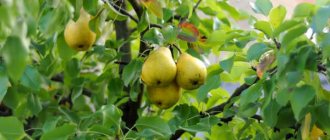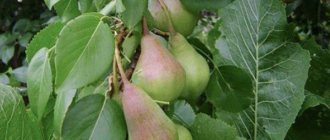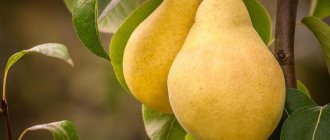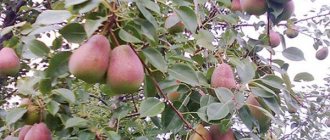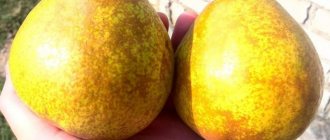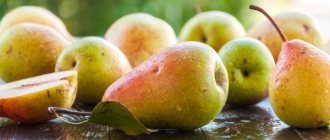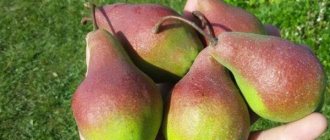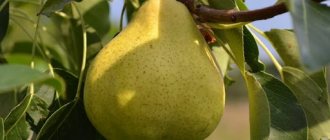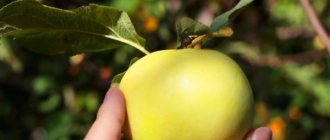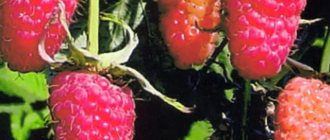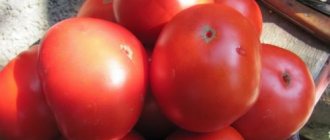Gardening » Pear
0
917
Article rating
Kira Stoletova
Among the varieties of pear fruit trees, most are obtained as a result of selection; these species are considered young, but there are some that are already hundreds of years old. These include a widespread variety, popular among gardeners, the Cure pear.
Description of Cure pear
Origin
One day, the Catholic priest (cure) Leroy, walking through the Fromenteau forest in France in 1760, discovered a pear seedling in it, the fruits of which he liked. The variety was named after the Catholic priest, Curé, and thanks to the efforts of this man, it was distributed throughout France. This pear variety is also known under other names: winter Williams, Pastorskaya, Zimnyaya large, Popskaya and Plebanovskaya.
The history of the Cure variety
The Cure pear was not the result of deliberate breeding work. She grew up in the forest as a random seedling, where she was found in 1760 by Curé Leroy. Thanks to him, the variety spread throughout Europe and subsequently migrated to more eastern countries.
Cure pear is also called winter Williams. There are also varieties with similar names: the old English summer pear Williams (Duchess summer) and Williams Rouge Delbara (Williams red), which is a spontaneous somatic mutant (clone) of the Williams variety. Both representatives of the culture are not related to the Williams winter pear (Cure).
The variety grows successfully in Ukraine, Moldova, Armenia, Azerbaijan and the Central Asian republics. In Russia, the pear was approved for cultivation in the North Caucasus region; it is popular in the Republic of Dagestan, the Kabardino-Balkarian, Chechen and Ingush Republics, North Ossetia, as well as in the Stavropol and Krasnodar territories.
Pear Cure: description, photos, reviews
Cure pear is a winter variety. The tree is durable, it is vigorous, has a dense and fairly leafy crown. The shape of the crown is wide-pyramidal (and when the tree reaches twelve years old, it is about 3.9 meters). With a large harvest, the branches of the tree are released downward and the crown becomes drooping. The main branches are located at an acute angle of 40-50 degrees in relation to the trunk. The color of the bark of mature trees is gray, the surface is full of cracks. Young trees have a smooth bark structure and are also gray in color. The main fruiting begins on branches 3-4 years old, rarely on two-year-old ones.
Pear variety Cure (Williams winter)
Curé is an early winter triploid pear variety of unknown origin. The seedling was discovered by chance in 1760 in France, in the forest of Fromenteau, Curé Leroy, thanks to whom the variety gained further distribution. Other names of the variety are Williams winter, Winter large, Pastorskaya, Plebanovka, Popskaya.
In 1947, the variety was sent for State testing and in the same year it was zoned in the North Caucasus region. Within Russia, this pear is most widespread in the Krasnodar and Stavropol Territories, in the southern part of the Astrakhan region, Crimea, Dagestan, Ingushetia, Chechnya, North Ossetia, Kabardino-Balkaria. It is also grown in Azerbaijan, Moldova, Armenia, in all zones of Ukraine and the republics of Central Asia.
The trees are vigorous and durable. The crown is well leafy, dense, and broadly pyramidal in shape (at the age of 12 years, the diameter of the crown is 3.9 meters). When the crop is loaded, the ends of the branches move down and the crown takes on a slightly drooping shape. The main branches extend from the trunk at an acute angle (approximately 45 - 50 degrees). The bark of the trunk and main skeletal branches is gray and covered with cracks; on young trees the bark surface is smooth, gray, without cracks. Fruiting is concentrated on 3-4 year old wood (less often on 2 year old wood), as well as on fruit trees.
The shoots are geniculate, medium or long in length, medium in thickness, light brown in color. The upper bark of annual shoots is burgundy-brown and slightly pubescent. Lentils are medium in size, oval in shape, light gray in color, and are rarely located on the shoot. The buds are medium in size, protruding, cone-shaped, with pointed tips, dark brown in color and covered with gray scales. The variety has good shoot formation ability. The leaves are dark green in color, medium in size, broadly ovate or almost round in shape, with raised edges and short tips bent downwards. There are fine serrated serrations along the edge of the leaves. The leaf blade has a smooth, glossy surface, rather thick, leathery. The petioles are small, thin, and often burgundy.
Flowering occurs early. The flowers are quite large in size, white in color, the anthers are dark pink.
The fruits of the Curé pear are above average (weighing 160 - 190 g) or large in size (weighing 200 - 250 g, there is also information about specimens weighing up to 500 g), slightly asymmetrical, elongated pear-shaped in shape. Closer to the calyx, the pears taper into a truncated cone shape. The skin is smooth, matte, quite thick and dense. When picked, the main color of the fruit is light green; when ripe, it is whitish-lemon-yellow. The cover color is expressed through a weak pinkish blush or is not visible at all. Subcutaneous points are small, barely noticeable, numerous. On individual fruits you can notice a characteristic feature of the variety: a rusty-brown stripe runs along the length of the entire pear, from the calyx to the stalk. The stalks are long, slightly curved, set obliquely (at an angle), the thickness is average, there is a thickening at the point of attachment of the branch; The adhesion of the stalk to the fruit is strong, and a fleshy tubercle grows in this place. The recess at the calyx is small, wide, smooth, and is often slightly rusty. The cup itself is large, open type; The sepals are large, elongated, and arranged in the shape of an asterisk in the calyx. The seed nest is medium-sized, elongated, surrounded by numerous granulations. The seed chambers are ovoid, tight, and have few seeds. The seeds are elongated, yellow-brown in color.
The pulp is usually white (in rare cases - yellowish or creamy), fine-grained consistency, medium density, tender, semi-melting, medium juicy, with a slight nutmeg aroma, slight astringency and granulations (stony cells) at the seed nest, often with a satisfactory sweet and sour taste. The flavor may be more grassy or virtually tasteless in unfavorable years. In general, the taste qualities of the Cure pear vary greatly depending on the growing conditions, so the tasting taste score is not too high and usually ranges from 3.0 to 3.5 points. But if, when picked early, the taste is clearly mediocre, then during storage the taste of the fruit still becomes better. According to the chemical composition, pears contain: dry matter (10.8%), total sugars (6.5%), titratable acids (0.7%), ascorbic acid (3.8 mg/100 g), P-active catechins (38.6 mg/100 g wet weight). The fruits are mainly consumed fresh, but are also often used for processing. The compotes are of mediocre taste (3.5 points).
In Kuban conditions, fruits are harvested between September 25 and October 8. Pears are often tied in bunches and are firmly held on the trees. When stored, they ripen for 15 - 20 days and are stored for 1 - 2 months. During the ripening process, the fruits quickly begin to turn brown and deteriorate. Under these conditions, their rapid implementation is required. When pears are overripe, they become painful. They remain in the refrigerator until January, maximum - until February. The variety tolerates transportation well.
The early fruitfulness of the Cure pear is assessed at an average level. Trees bear fruit from the 5th - 6th year, on quince - from the 4th - 5th year. The variety works best on well-developed rootstocks (wild pear seedlings) and quince. Trees grow very well on quince rootstock and often grow on their own roots. It was also noted that the largest fruits (weighing up to 500 grams) grow on quince rootstocks. It is important to note that in nursery conditions, seedlings of this variety develop at a very fast pace. In this regard, they are often used as an intermediate insert for those pear varieties that do not succeed on quince. Pruning is usually carried out by thinning thickening branches in the crown and slightly shortening the continuation shoots.
The tree is self-sterile. The best pollinators of Cure include the following varieties: Williams, Lyubimitsa Klappa, Bere Bosc, Bere Ardanpont, Olivier de Serre, Winter Deccan, Duchess Angoulême, Saint-Germain.
The variety is highly productive. Fruiting is often regular and generous. In the conditions of the central part of Kuban, the average yield of 17 - 20 year old trees is 150 - 180 c/ha; in the foothills zone, 24 - 26 year old trees produce up to 200 - 250 c/ha (or up to 200 - 300 kg/tree). From individual 20-25 year old trees, up to 500-600 kg of fruit can be collected in favorable years.
This pear is quite winter-hardy and drought-resistant. In case of freezing, the trees recover well and quickly, continuing to bear abundant fruit. Despite the fact that under favorable growing conditions the fruits and leaves are not affected by scab, the variety is still moderately resistant to scab. During epiphytotic years, the level of susceptibility to this fungal disease exceeds 2 points.
The variety is, in principle, undemanding in terms of growing conditions and can grow on any soil. However, it prefers light, fairly moist soils. It is also very demanding of heat; in cool summer conditions, the fruits do not reach the required level of sugar content.
Speaking about the advantages of the Cure pear, they highlight: despite the possible frequency, a consistently high level of productivity; large fruits; good winter hardiness; unpretentiousness to growing conditions.
The main disadvantages include: the mediocre taste of the fruits (tartness, stony cells, tastelessness in some years) and their shrinkage when overloaded with the harvest, and susceptibility to scab in wet years.
Fruit
Individual specimens of pears of this variety can reach 500 grams, the average weight ranges from 160 to 250. The fruits are slightly asymmetrical, slightly elongated pear-shaped. The peel is quite dense, thick, matte and smooth. When harvested, the color of the fruit is light green; when ripe, it is a light lemon yellow color. Some specimens have a faint pink blush. A distinctive feature of this variety can be considered a narrow rusty-brown strip running along the entire length of the pear. The seed nest is usually small in size, the seed chambers are ovoid, and the pear contains a small number of seeds. The seeds are elongated, yellow-brown in color.
The pulp of the fruit is most often white, sometimes creamy, of medium density, fine-grained consistency. The taste of the fruit is delicate, with an average juice content, with a weak nutmeg aroma, and has a slight tartness. If there is not enough sun during cultivation, the fruits may taste sour.
Under unfavorable conditions, the Curé pear can have a grassy taste or be completely tasteless. Taste qualities also depend on the growing region. The tasting score for this pear variety is low and reaches only 3 to 3.5 points.
Planting and caring for the Cure pear
Although it is believed that this variety is undemanding in terms of soil composition, it grows and bears fruit better on light loamy soils. When planting, it is also necessary to ensure that the roots do not get wet due to the proximity of groundwater.
Caring for the Cure pear is required, but it is ordinary and nothing special. It includes:
- watering;
- feeding;
- pruning;
- mulching the circle around the trunk and loosening it;
- shelter for the winter and taking protective measures in case of recurrent frosts in the spring.
Landing rules
The Cure variety pear is planted according to the same rules as all other representatives of this crop. It is only necessary to take into account the size of an adult tree in the future and for full development, plant according to the pattern of 4.5-5 m between bushes, 5.5-6 m between rows.
Watering and fertilizing
Watering for pears should be regular. The tree tolerates drought well and can quickly recover from a lack of water, but it needs moisture for rich fruiting.
Fertilizer application has a beneficial effect on the quantity and taste of fruits. Therefore, you can fertilize with standard complex fertilizers and humus. In autumn, during prolonged dry weather, the pear tree is watered abundantly and phosphate fertilizers are applied. In the spring - nitrogen fertilizers, and in early summer they are fed with potassium supplements.
Trimming
Cure pear needs sanitary pruning, which is best done in the spring before sap flow begins. Damaged and dry branches should be removed, as well as frostbitten ones if they appeared over the winter.
Along with sanitary pruning, it is recommended to thin out the crown. Since the Cure pear has a dense crown, reducing the number of branches will have a positive effect on the yield and taste of the fruit.
Whitewash
Pears are whitened in spring and autumn to protect against pests. Insect larvae and fungal spores living in the bark die after whitewashing. Use lime or water-based paint. Whitewashing is carried out to approximately 1 m from the ground.
Preparing for winter
The Curé variety is winter-hardy and tolerates short frosts well. But if it happens that the tree freezes, it takes a break from bearing fruit and quickly recovers.
In areas with severe frosts, it is recommended to insulate the trunks and root system for the winter using building insulation, spruce branches, dry leaves and grass.
Fruit composition
This variety is valued for its large amount of vitamin P; it is useful for people with stomach and intestinal problems. 100 grams of fruit contains:
- 6.5 g sugar;
- 39 mg vitamin P;
- 3.8 mg vitamin C;
- 7 mg titratable acids.
The Curé pear variety is considered highly productive: the older the tree, the higher the yield. In a climate favorable for this crop, for example in the Kuban, the yield from a 15-year-old pear is 180 centners per hectare, and in the foothills of the Caucasus, a 25-year-old tree yields a harvest of 250 centners. The fruits begin to be harvested from the end of September to the beginning of October. It is not recommended to keep the fruits on trees, otherwise the pear pulp will become mealy and tasteless. It is recommended to use it for food after 20 days from the end of harvest, when the pears are ripe.
Landing rules
The plant loves a sunny and warm place with a low groundwater level. Prefers loamy and slightly acidic soils. In the first year after planting the seedlings, it is recommended to insulate the trunk to avoid freezing and death of the crop. Seedlings should be planted in early spring, when the snow melts, or in autumn.
To do this, make holes 20-25 cm deep. Organic fertilizers are added to them: humus, peat, black soil, rotted straw, compost. The tree is planted in such a way that the root collar of the seedling remains above the ground surface. It is covered with earth and compacted tightly. The soil is watered abundantly.
Fertilizing is carried out only after 2 years.
The tree requires standard care:
- water;
- feed;
- trim.
Advantages
The advantages of this variety should be noted:
- Cure pear develops well and produces high yields on forest pear and quince rootstock.
- Has high transportability.
- The variety is unpretentious and does not require special care.
- Cure pear pollen is sterile.
- The variety has good drought resistance and winter hardiness.
Disadvantages include the mediocre taste of the fruit, stony cells, sometimes tastelessness, and excessive astringency. In a damp summer, the tree can be affected by scab, and overload with the harvest affects the size of the fruits, they become smaller.
How is the variety pollinated?
Winter Williams has a triploid (triple) set of chromosomes; in most representatives of the culture it is diploid (double). All triploid pear varieties are self-sterile, and they also have sterile pollen and cannot pollinate either their own kind or diploid pears. For the Cure variety, Williams, Lyubimitsa Klappa, and Olivier de Serre pears are recommended as the best sources of pollen. There is also information about the following possible pollinators:
- Bere Bosc;
- Bere Ardanpont;
- Dekanka winter;
- Duchess Angoulême;
- Saint Germain.
The Curé variety is self-sterile; it requires cross-pollination for full fruiting.
Features of cultivation
This crop should be grown in well-lit, sunny places. Seedlings should be protected from draft winds. Like all fruit crops, pears do not like close groundwater. It is preferable to plant trees in light, fertile soils. To increase productivity, it is necessary to comply with some requirements annually, such as pruning pear trees, timely fertilizing and watering. Tree trunk circles must be weeded and mulched. If a harsh winter is expected, trees must be insulated. Ready-made compounds and any organic fertilizers are used as fertilizers.
Advantages and disadvantages
Each gardener decides for himself which qualities are more significant for him in this variety, and to what extent the conditions of his site correspond to the pear showing its best qualities.
Advantages of Cure pear:
- high productivity;
- large fruit;
- winter hardiness;
- good transportability.
In addition, the tree is relatively unpretentious to growing conditions, but it is not worth exposing the crop to terminal environmental influences. The same applies to the choice of soil and planting site.
Flaws:
- mediocre taste of the fruit;
- limited types of processing (cook or dry);
- influence of weather conditions on taste;
- instability to fungal infection at high humidity;
- limited shelf life;
- pollen sterility.
Much depends on what crop was used as the rootstock. Quince and Forest Pear are the best for Cure Pear.
Storage
Let's look at how to store Cure pears correctly. For storage you should take only dry fruits; it’s good if they dry naturally. The best place to store crops is in a basement or pantry. They are always dark, cool and dry. A warm room cannot be used, as the crop will rot very quickly in it. The best temperature is considered to be zero degrees; storage at a temperature of +1 °C is allowed. Humidity must be at least 80%, even better if it is 85%. First you need to prepare the room, it is advisable to whitewash the ceiling and walls with lime. Then you should ventilate it well. It’s good if there is ventilation in this room; fruits, and other crops, are stored longer in ventilated rooms. It is recommended to lay the fruits in layers and cover each layer with dry shavings or straw.
Aftercare
In order for the seedling to have a strong trunk and fluffy crown, it is necessary to systematically control the growth of the tree. This includes feeding, watering, and protection from rodents. During the season, in the first year, fertilizing is applied twice. The first - in May, when the buds have already bloomed, and the second - after flowering. For this purpose, mineral fertilizers or ash are applied at a rate of 70-80 g per 10 liters of water into small holes under the tree. You can also dilute bird droppings in water 1:15 and pour this mixture into the depressions next to the plant.
Important! After planting, the tree is watered 3 times a year. To prevent moisture from leaving after watering, a layer of mown grass is placed next to the trunk, thus mulching the plant.
To prevent the tree from becoming overgrown, shoots are periodically pruned from the second year after planting. In early spring, in March, branches are cut at a distance of 50 cm from the surface of the ground. The first shoots are systematically pruned by 20 cm. In subsequent years, the pruning is reduced, but if the tree is thickened and its internal shoots intertwine with the external ones, then the internal branches are cut off. This prevents the crown of the tree from darkening and protects it from depletion.
Methods of protection against rodents:
Protection from rodents is an important task: the root system and bark of a tree trunk attract mice. For this purpose, the following procedures are carried out:
- Coating with a mixture of 500 g of sunflower oil and 2 - 3 ml of Creolin. This composition protects not only from mice, but also from ticks.
- Prepare lime whitewash with copper sulfate.
- The trunk is mulched with sawdust impregnated with birch tar in a ratio of one tbsp. l. birch tar per 10 liters of water.
- Special dry “fas-double” granules are added along the perimeter of the tree to protect against mole crickets, ants, fleas and pest larvae.
- For the winter, wrap the tree trunk with two layers of roofing material and secure the material: this helps cut off the rodents’ path to the bark and branches.
- The snow around the tree is periodically compacted, making it impossible for mice to dig a hole.
Pests and diseases
Spraying, which is carried out 3-4 times per season, helps rid the Curé pear from diseases and pests. An unpleasant misfortune is brown spotting. Light brown or deep brown spots appear on the leaves, reminiscent of sunburn. Such leaves should be immediately plucked and burned. Then treat with one percent copper sulfate, and a day later - with 1% Bordeaux mixture. Coccomycosis is treated with Photoform, Commander and iron sulfate. When spraying, these products alternate.
Plants aged 1 - 3 years are susceptible to a scourge called scab, a sign of which is green-brown spots on the leaves of the tree. Then the leaves turn yellow and fall off in the summer. To combat this disease, fallen leaves are immediately collected, and the trunk and branches are treated with drugs: 1% Bordeaux mixture, Raykom, Fitosporin-M. It is better to spray trees before flowering or immediately after fruit set.
Harvesting
Fruit ripeness occurs in the second half of September. The pears are firmly held on the shoot, 2 - 3 pieces together or individually. If you pick them for storage in early September, the fruits will lie and ripen until February. To do this, the Cure pears are carefully cut off, with the stem attached, and carefully placed in wooden boxes with sawdust.
How to store Cure pears
For fresh use, pear fruits are removed with stems in September. They are carefully placed in a refrigerator container on the bottom shelf. In this way, the fruits are well stored and gradually ripen completely: they can last until November-December, or even February.
The storage option in wooden boxes is suitable for a cellar. The fruits are carefully sorted, placed in a layer on the bottom of the boxes, covered with white paper and a second layer is made again. On top - the last layer - there will again be sheets of paper.
Attention! It is not recommended to lay pears in more than two layers. Fruits need to “breathe” to maintain aroma and freshness in winter.
In production volumes, pears are stored in special storage facilities with refrigeration equipment at a temperature of +3 - 4 °C. The premises are periodically, once every 3 days, ventilated with constantly running fans. In such conditions, the fruits are stored until spring.
Harvesting and preparing for winter
The fruits begin to form towards the end of September. Since the weight can reach more than 200 grams, it is recommended to pick pears in advance; they may fall off. If the fruit lies on the ground, it is no longer suitable for consumption.
Curé has a high shelf life of fruits. Harvested green pears fully ripen within 14-20 days, the taste improves significantly, becoming richer and sweeter. The transportability of the fruits is good; they do not crush or wrinkle even when transported over long distances due to their hard pulp.
Attention! Pears are stored in a cool, dark place. You can store fruits in the refrigerator, but separately from other vegetables and fruits.
Before wintering, the soil is mulched annually in mid-October with peat, sawdust or straw. The mulch is laid in a uniform layer around the perimeter of the entire trunk circle. One mulch is enough for the tree to easily survive the winter.
Pests and diseases
A preventive measure to combat pests and fungi is whitewashing wood with lime. It is recommended to carry out the procedure in the spring. Since the variety has high immunity to various diseases, garden treatment is not always required.
But, if the summer is hot and dry, it is recommended to treat the pear with preparations such as Zircon and Agat-25. This will prevent the tree from becoming infected with diseases and prevent the appearance of scab. Also, to prevent scab from attacking the tree, it is important to regularly trim old and damaged branches.
